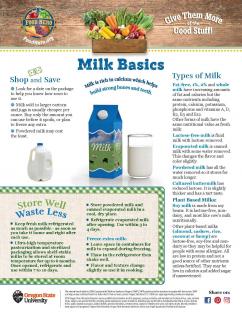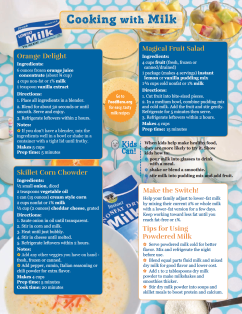Milk Basics
Milk is rich in calcium which helps build strong bones and teeth.
Shop and Save
- Look for a date on the package to help you know how soon to use it.
- Milk sold in larger cartons and jugs is usually cheaper per ounce. Buy only the amount you can use before it spoils, or plan to freeze any extra.
- Powdered milk may cost the least.
Store Well Waste Less
- Keep fresh milk refrigerated as much as possible - as soon as you take it home and right after each use.
- Ultra-high temperature pasteurization and sterilized packaging allows shelf-stable milks to be stored at room temperature for up to 6 months.
- Once opened, refrigerate and use within 7 to 10 days.
- Store powdered milk and canned evaporated milk in a cool, dry place.
- Refrigerate evaporated milk after opening. Use within 3 to 4 days.
Freeze extra milk:
- Leave space in containers for milk to expand during freezing.
- Thaw in the refrigerator then shake well.
- Flavor and texture change slightly so use it in cooking.
Types of Milk
Fat-free, 1%, 2% and whole milk have increasing amounts of fat and calories but the same nutrients including protein, calcium, potassium, phosphorus and vitamins A, D, B2, B3 and B12.
Other forms of milk have the same nutritional value as fresh milk:
Lactose-free milk is fluid milk with lactose removed.
Evaporated milk is canned milk with some water removed. This changes the flavor and color slightly.
Powdered milk has all the water removed so it stores for much longer.
Cultured buttermilk has reduced lactose. It is slightly thicker and has a tart taste.
Plant Based Milks:
Soy milk is made from soy beans. It is lactose-free, nondairy, and most like cow’s milk nutritionally.
Other plant-based milks (almond, cashew, rice, coconut or hemp) are lactose-free, soy-free and nondairy so they may be helpful for people with some allergies. All are low in protein and not a good source of other nutrients unless fortified. They may be low in calories and added sugar if unsweetened.
Cooking with Milk
Make the Switch!
Help your family adjust to lower-fat milk by mixing their current 2% or whole milk with a lower-fat version for a few days. Keep working toward less fat until you reach fat-free or 1%.
Tips for Using Powdered Milk
- Serve powdered milk cold for better flavor. Mix and refrigerate the night before use.
- Blend equal parts fluid milk and mixed dry milk for good flavor and lower cost.
- Add 1 to 2 tablespoons dry milk powder to make milkshakes and smoothies thicker.
- Stir dry milk powder into soups and skillet meals to boost protein and calcium.
Recipes
Orange Delight
Skillet Corn Chowder
Magical Fruit Salad
Kids Can!
When kids help make healthy food, they are more likely to try it. Show kids how to:
- pour milk into glasses to drink with a meal.
- shake or blend a smoothie.
- stir milk into pudding mix and add fruit.




